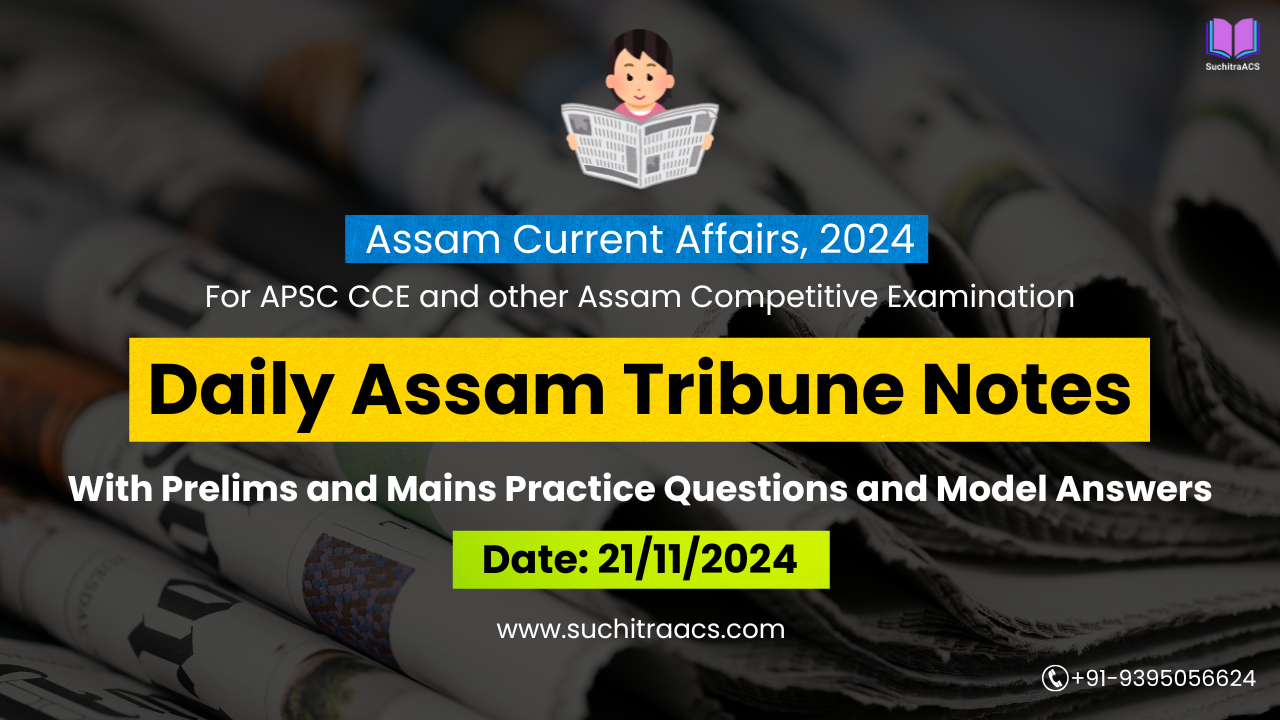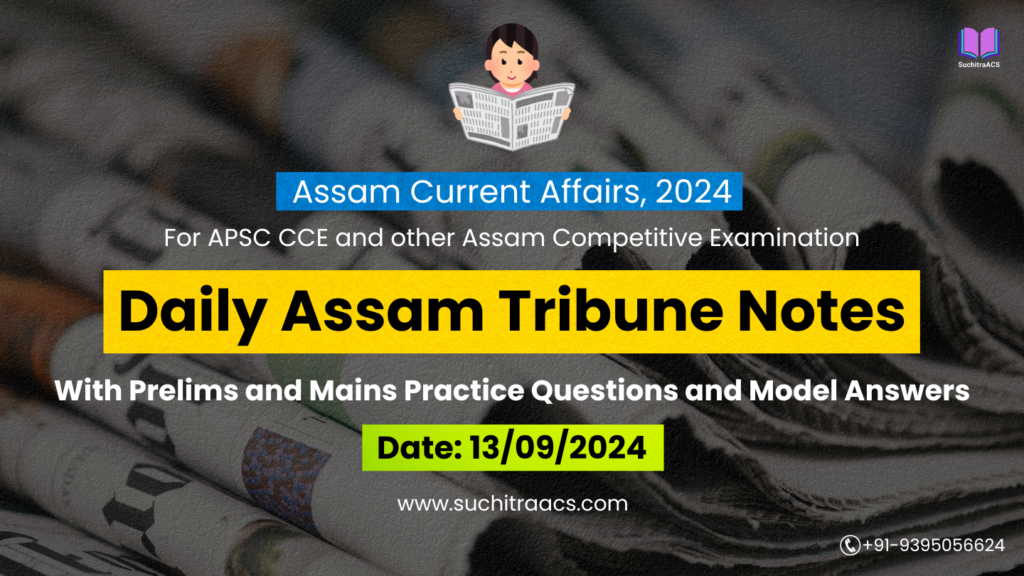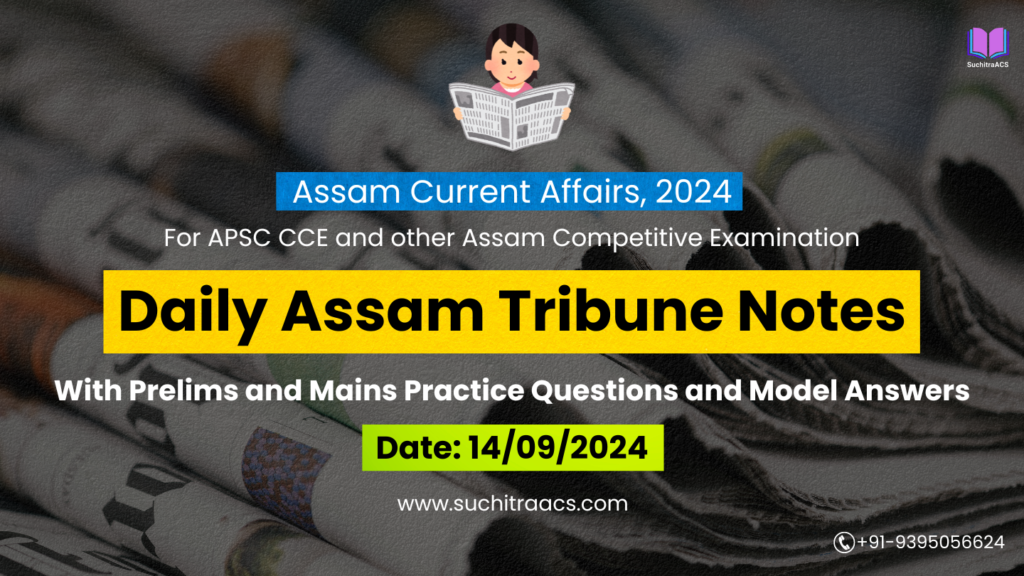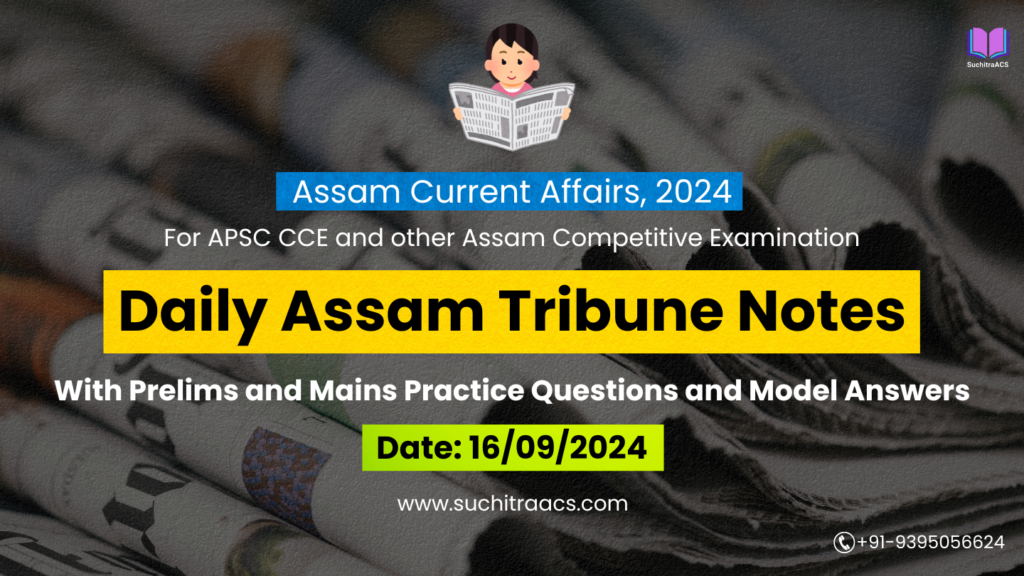APSC Current Affairs: Assam Tribune Notes with MCQs and Answer Writing (21/11/2024)
For APSC CCE and other Assam Competitive examinations aspirants, staying updated with current affairs is vital. This blog covers most important topics from the Assam Tribune today (21-11-2024). These issues are key for both APSC Prelims and Mains preparation, offering insights into the APSC CCE Syllabus.
1. Elevated Corridor in Kaziranga National Park
Relevant for: GS Paper 3: Environment and Biodiversity
Introduction:
The Supreme Court has directed the National Highways Authority of India (NHAI) to expedite the construction of a 34-km elevated corridor in Kaziranga National Park. This project aims to mitigate the impact of traffic on wildlife and enhance conservation efforts.
Key Facts:
- Project Scope: A four-lane elevated road along NH-715, including two tunnels for wildlife crossings.
- Objective: To connect fragmented habitats within Kaziranga and ensure free wildlife movement.
- Collaborators: NHAI, Ministry of Road Transport and Highways (MoRTH), and Wildlife Institute of India.
Prelims Pointers:
- Kaziranga National Park: A UNESCO World Heritage Site, home to the one-horned rhinoceros.
- NH-715: Previously NH-37, runs through Assam and serves as a critical corridor.
- Wildlife-Friendly Infrastructure: Includes underpasses and overpasses for animal crossings.
Mains Pointers:
- Importance:
- Reducing Roadkill: Decreases roadkill incidents by providing safe passages for wildlife.
- Enhancing Biodiversity: Facilitates the movement of wildlife, thus supporting biodiversity conservation.
- Sustainable Development: Aligns with India’s commitments to sustainable development and conservation.
- Habitat Connectivity: Restores and maintains habitat connectivity disrupted by roadways.
- Challenges:
- Cost and Delays: High project costs and potential delays in execution.
- Displacement Issues: Potential displacement of local communities during construction.
- Monitoring: Challenges in monitoring wildlife usage of the infrastructure.
- Government Initiatives:
- Project Tiger: Incorporation of wildlife-friendly infrastructure policies.
- Research Integration: Use of Wildlife Institute of India’s research for planning and implementation.
- Way Ahead:
- Strict Timelines: Ensure adherence to strict timelines for project completion.
- Community Engagement: Engage local communities to minimize displacement and address concerns.
- Monitoring Mechanisms: Implement transparent and robust monitoring mechanisms to track wildlife usage.
Conclusion:
The Kaziranga elevated corridor represents a critical intervention for conserving Assam’s unique biodiversity while addressing infrastructure needs.
2. Swahid Smarak Kshetra Project in Guwahati
Relevant for: GS Paper 1: Modern Indian History; GS Paper 2: Governance
Introduction:
The Swahid Smarak Kshetra is a memorial under construction to honor the martyrs of the Assam Agitation. Scheduled for inauguration by December 10, it symbolizes the sacrifices of those who fought for Assamese identity.
Key Facts:
- Location: Paschim Boragaon, Guwahati.
- Project Cost: ₹100 crore.
- Features: Includes a 225-foot tower, meditation hall, photo gallery, and ethnic cuisine outlet.
Prelims Pointers:
- Assam Agitation (1979-1985): Movement against illegal immigration in Assam.
- Swahid Divas: Observed on December 10 to honor martyrs, marking the death of Khargeswar Talukdar.
Mains Pointers:
- Importance:
- Historical Preservation: Preserves the historical legacy and memories of the Assam Agitation.
- Cultural and Educational Impact: Enhances cultural and educational awareness regarding the agitation.
- Tourism and Identity: Boosts local tourism and strengthens regional identity.
- Challenges:
- Documentation: Difficulty in accurately documenting all 855 martyrs.
- Maintenance Costs: High maintenance costs for the memorial complex.
- Political Exploitation: Risk of political exploitation of the agitation’s legacy for gain.
- Government Initiatives:
- Support: Financial and logistical support for the project.
- Tourism Integration: Integration with Assam’s tourism promotion strategies.
- Way Ahead:
- Community Management: Involve the community in managing and maintaining the memorial.
- Educational Programs: Incorporate educational programs on Assam’s history and the Assam Agitation.
Conclusion:
The Swahid Smarak Kshetra serves as a cultural landmark, ensuring the sacrifices of the Assam Agitation martyrs remain etched in public memory.
3. AASU Protests Against Price Rise
Relevant for: GS Paper 2: Governance; GS Paper 3: Economy
Introduction:
The All Assam Students’ Union (AASU) has launched statewide protests against the rising prices of essential commodities, accusing the government of neglecting the plight of common citizens.
Key Facts:
- Protests: Conducted in Guwahati and district headquarters across Assam.
- Demands: Immediate government intervention to stabilize prices of food, medicines, and daily necessities.
Prelims Pointers:
- AASU: A prominent student organization instrumental in the Assam Agitation.
- Essential Commodities Act, 1955: Legislation aimed at regulating the supply of essential items.
Mains Pointers:
- Importance:
- Economic Challenges: Highlights the economic challenges faced by ordinary citizens.
- Government Accountability: Brings attention to lapses in government accountability and market regulation.
- Challenges:
- Enforcement Issues: Weak enforcement of anti-hoarding and profiteering measures.
- Supply-Chain Inefficiencies: Limited capacity of state agencies to control supply-chain inefficiencies.
- Government Initiatives:
- Price Control: Mechanisms under the Public Distribution System (PDS).
- Subsidy Programs: Programs for subsidizing key commodities.
- Way Ahead:
- Enforcement: Strengthen enforcement of the Essential Commodities Act.
- Price Stabilization: Introduce price stabilization funds for critical items.
- Supply Chain Improvements: Implement long-term supply chain improvements to ensure stable prices.
Conclusion:
Addressing price rise demands a multi-pronged approach, combining stringent regulation with long-term supply-chain improvements.
4. Noonmati-Dighalipukhuri Flyover Concerns
Relevant for: GS Paper 3: Urbanization and Environment
Introduction:
Leader of Opposition Debabrata Saikia has raised concerns about environmental and civic issues caused by the Noonmati-Dighalipukhuri flyover project, calling for a temporary halt until mitigation measures are implemented.
Key Facts:
- Issues Highlighted: Air pollution, noise, traffic congestion, dust, and waterlogging.
- Project Objective: Addressing transportation bottlenecks in Guwahati.
Prelims Pointers:
- Noonmati-Dighalipukhuri Corridor: A major infrastructure project in Assam’s capital.
- PM10 and PM2.5 Levels: Indicators of air quality impacted by construction dust.
Mains Pointers:
- Importance:
- Urban Mobility: Improves urban mobility and reduces commute times.
- Economic Activities: Facilitates economic activities by enhancing connectivity.
- Challenges:
- Pollution: Increased pollution and health issues for nearby residents.
- Waterlogging: Due to blocked drainage systems.
- Displacement: Displacement of street vendors affecting livelihoods.
- Government Initiatives:
- Pollution Control: Norms for pollution control at construction sites.
- Public Consultations: To address grievances and community concerns.
- Way Ahead:
- Dust Suppression: Implement techniques like water sprinkling to control dust.
- Drainage Plans: Develop effective drainage plans to prevent waterlogging.
- Temporary Markets: Create temporary markets for displaced vendors to continue their business.
Conclusion:
Sustainable urban planning and robust environmental safeguards are essential for balancing development with quality of life.
5. Awareness Program on Pediatric Diabetes
Relevant for: GS Paper 2: Health and Education
Introduction:
Apollo Excelcare Hospital has conducted an awareness program to address the rising prevalence of Type 1 diabetes in children, focusing on holistic management and early detection.
Key Facts:
- Key Organizer: Dr. Manash Pratim Baruah, endocrinologist.
- Initiative: Formation of a support group for families managing Type 1 diabetes.
Prelims Pointers:
- Type 1 Diabetes: Autoimmune condition often diagnosed in childhood.
- Diabetes Management: Includes insulin therapy, diet, and emotional support.
Mains Pointers:
- Importance:
- Early Detection: Promotes early detection and reduces complications.
- Emotional Support: Provides emotional and social support for families.
- Reduce Stigma: Reduces stigma and societal biases against chronic illnesses.
- Challenges:
- Awareness: Limited awareness among parents and educators.
- Cost: High cost of insulin and monitoring equipment.
- Government Initiatives:
- NPCDCS: National Program for Prevention and Control of Cancer, Diabetes, CVDs, and Stroke.
- Subsidized Insulin: Programs under public health schemes to provide affordable insulin.
- Way Ahead:
- School Programs: Strengthen school-based health programs for early screening.
- Affordable Access: Ensure affordable access to diabetes management tools.
Conclusion: Awareness programs on pediatric diabetes are vital for early intervention and holistic care, ensuring a better quality of life for affected children.
APSC Prelims Practice Questions
1. Elevated Corridor in Kaziranga National Park
Question 1:
Which of the following is true about the elevated corridor project in Kaziranga National Park?
- It includes a 34-km elevated road along NH-715.
- The project aims to enhance habitat connectivity for wildlife.
- The Wildlife Institute of India is not involved in this project.
Select the correct answer using the code given below:
A. 1 and 2 only
B. 1 and 3 only
C. 2 and 3 only
D. 1, 2, and 3
Answer: A
Explanation:
- Statement 1 is correct: The project includes a 34-km elevated corridor.
- Statement 2 is correct: It is designed to enhance habitat connectivity.
- Statement 3 is incorrect: The Wildlife Institute of India is collaborating on the project.
2. Swahid Smarak Kshetra Project in Guwahati
Question 2:
What is the significance of the Swahid Smarak Kshetra project in Guwahati?
- It commemorates the Assam Agitation martyrs.
- It includes a meditation hall and ethnic cuisine outlet.
- It is the largest memorial of its kind in India.
Select the correct answer using the code given below:
A. 1 only
B. 1 and 2 only
C. 2 and 3 only
D. 1, 2, and 3
Answer: B
Explanation:
- Statement 1 is correct: It commemorates the Assam Agitation martyrs.
- Statement 2 is correct: The memorial features a meditation hall and an ethnic cuisine outlet.
- Statement 3 is incorrect: The project is significant for Assam but is not the largest in India.
3. AASU Protests Against Price Rise
Question 3:
Which of the following are objectives of the Essential Commodities Act, 1955?
- Regulate the production and supply of essential items.
- Prevent hoarding and black marketing.
- Stabilize prices of essential goods.
Select the correct answer using the code given below:
A. 1 and 2 only
B. 2 and 3 only
C. 1 and 3 only
D. 1, 2, and 3
Answer: D
Explanation:
- All three statements are correct. The Act aims to regulate supply, prevent hoarding, and stabilize prices of essential commodities.
4. Noonmati-Dighalipukhuri Flyover Concerns
Question 4:
Which of the following environmental issues have been raised regarding the Noonmati-Dighalipukhuri flyover project?
- Increase in PM10 and PM2.5 levels.
- Displacement of street vendors.
- Blocked drainage leading to waterlogging.
Select the correct answer using the code given below:
A. 1 only
B. 1 and 3 only
C. 1, 2, and 3
D. 2 and 3 only
Answer: C
Explanation:
- All listed issues—air pollution (PM10 and PM2.5), vendor displacement, and waterlogging—are associated with the flyover project.
5. Awareness Program on Pediatric Diabetes
Question 5:
Which of the following is true about Type 1 diabetes?
- It is an autoimmune condition commonly diagnosed in childhood.
- Insulin therapy is the primary treatment.
- It can be prevented through vaccination.
Select the correct answer using the code given below:
A. 1 and 2 only
B. 2 and 3 only
C. 1 and 3 only
D. 1, 2, and 3
Answer: A
Explanation:
Statements 1 and 2 are correct: Type 1 diabetes is autoimmune and treated with insulin therapy. Statement 3 is incorrect: There is no vaccine to prevent Type 1 diabetes.
APSC Mains Practice Question
Topic: Elevated Corridor in Kaziranga National Park
GS Paper 3: Environment and Infrastructure
The construction of wildlife-friendly infrastructure, such as the elevated corridor in Kaziranga National Park, reflects a balance between conservation and development. Discuss the significance of this project for biodiversity conservation and sustainable development. Highlight the challenges and suggest measures to ensure its success.
Model Answer
Introduction:
Kaziranga National Park, a UNESCO World Heritage Site in Assam, is home to a diverse range of flora and fauna, including the endangered one-horned rhinoceros. The Supreme Court’s directive to expedite the construction of a 34-km elevated corridor along NH-715 aims to mitigate the impact of vehicular traffic on wildlife, ensuring habitat connectivity and reducing roadkill. This project represents a critical step in balancing biodiversity conservation with infrastructure development.
Significance of the Elevated Corridor:
- Biodiversity Conservation:
- Reduces wildlife-vehicle collisions by providing safe crossings for animals, including rhinos, elephants, and tigers.
- Restores connectivity between fragmented habitats, crucial for genetic diversity and ecosystem resilience.
- Sustainable Development:
- Aligns with India’s commitments to the United Nations Sustainable Development Goals (SDG 15: Life on Land).
- Supports eco-tourism by preserving Kaziranga’s unique biodiversity.
- Economic Benefits:
- Ensures smooth transportation for local communities and trade without compromising conservation goals.
- Promotes long-term regional growth by integrating conservation with development.
- Policy Leadership:
- Demonstrates India’s commitment to incorporating wildlife-friendly infrastructure into national projects.
Challenges in Implementation:
- High Costs and Delays:
- The project involves significant financial outlays, and delays could escalate costs further.
- Community Concerns:
- Potential displacement and disruption of livelihoods for local communities living near the project site.
- Monitoring and Effectiveness:
- Ensuring wildlife adapts to using underpasses and overpasses remains a challenge.
- Environmental Disruptions During Construction:
- Temporary habitat loss, air pollution, and noise pollution during the construction phase could negatively impact wildlife.
Measures to Ensure Success:
- Robust Monitoring Mechanisms:
- Utilize technologies such as drones and camera traps to monitor wildlife usage of the corridor post-construction.
- Community Engagement:
- Actively involve local communities in the planning and implementation process to address concerns and ensure cooperation.
- Environmental Safeguards:
- Implement eco-friendly construction practices, such as dust suppression and noise mitigation measures.
- Capacity Building:
- Train forest officials and highway contractors in wildlife management and monitoring.
- Strict Timelines and Accountability:
- Ensure project completion within a defined timeframe, with regular audits and progress reviews.
Conclusion:
The elevated corridor in Kaziranga National Park is a model initiative demonstrating the coexistence of development and conservation. By addressing challenges through innovative solutions and inclusive approaches, this project can serve as a blueprint for similar endeavors nationwide, securing India’s rich biodiversity while supporting its infrastructure goals.
✨ APSC Prelims Crash Course, 2025
at most affordable rate in Assam!

🔔 Join Our WhatsApp Study Group!
For exclusive access to premium quality content, including study materials, current affairs, MCQs, and model answers for APSC CCE and other Assam competitive exams.
Click here to join: SuchitraACS Study WhatsApp Group
📚 Want to know more about SuchitraACS’s most affordable courses?
Click here to know more: SuchitraACS Courses for APSC CCE and Assam Competitive Examinations




